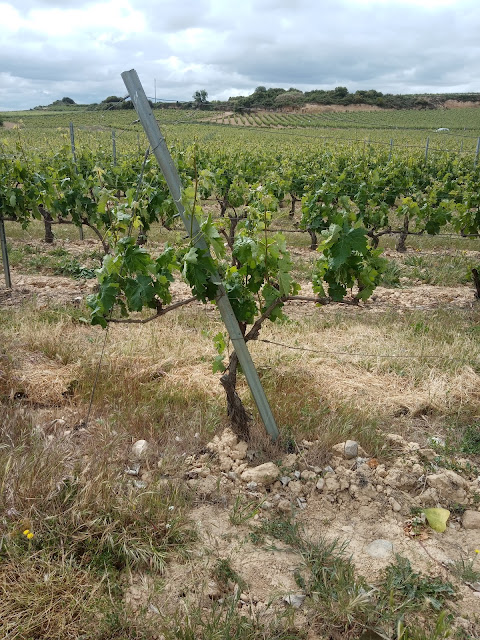We arrive in Haro at midnight, where, in true Spanish fashion, our host Francisco proposes a drink. A lone bar is open, and the silent streets and empty room suggest they might consider shutting early on a Monday. Most of us order a caña as George Michael plays on the speakers and an alsatian sniffs around and howls for attention. Despite the delicious cold beer, I decide against a tour of the deserted town and crash out in a huge room with oak beams on the ceiling.
 |
| Tempranillo vines at La Rioja Alta S.A. |
The last time I went to Spain was four years ago, yet, as I wander around this famous wine town the next morning, waves of familiarity wash over me. A man's voice booms out from a café; a half-hidden figure leans out of a second floor window and beats a mat againt the wall; two nuns in black habits walk past a church; a woman stands on a street corner selling lottery tickets. There are old buildings with long cracks down the middle, and lovely views beyond the town over to hills and vines.
I came here for the wine, of course, and the sight of a row of trees shaped like gobelet vines turns my mind to the tasting ahead of us. We drive the short distance to my favourite Rioja producer, La Rioja Alta S.A., in the Barrio de la Estación. I ask Francisco, who is driving, which Rioja he likes the most, other than his employer's. 'Who asked this question?!', he jokes.
The wines are lined up for us in a crescent: eight reds and a solitary white - 'to cleanse the palate'. I'm not usually a big fan of whites, but the Lagar de Cervera Albariño is delicious, with peachy aromas redolent of Viognier.
Although I've had most of the reds many times before, it's a joy to drink them again. My favourites are the 2015 and 2016 vintages of Viña Ardanza. 'The Garnacha is the DNA of Ardanza', says Francisco. 'It brings spice, liquorice' to the wine. The Garnacha grapes are grown on vineyards covered in huge pebble stones, 50 miles away in the hotter Rioja Oriental zone, we learn. 'The winemaker calls it little Châteauneuf-du-Pape', says Francisco.
 |
| Garnacha vines in Rioja Oriental |
We don't finish all the tasting samples, which feels almost like a crime considering the quality of the wines. (A member of the party later tells me he went round the table polishing off all the flagship Gran Reserva 890, however).
Over a lunch of Riojan vegetable stew and barbecued lamb cutlets, we drain the remainder of the 890, plus several more bottles of the Ardanza, including a velvety 2005 vintage. I ask in Spanish for more of the vegetable dish. 'His Spanish is good!' the waitress tells Francisco, filling me with pride.
This was my first trip abroad in over three years. I returned home tired but euphoric, with three goals: to go back to Spain; to drink lots of wines made by La Rioja Alta S.A.; to take up Spanish again. I can certainly achieve the first two objectives; we'll see about the third...



